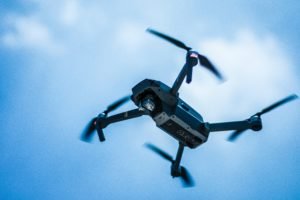Drone professionals have a major investment in their aerial assets – but water and other environmental factors can ruin delicate electronics. Some waterproofing methods add weight and reduce battery life. Plasma nanocoating could be the solution.
The following is a guest post by Simon Vogt, CCO of liquid repellent nanotech firm P2i. DRONELIFE neither accepts nor makes payments for guest posts.
The drone market has grown significantly in the last few years, with both hobbyists and professional users alike taking great interest in exploring the capabilities these devices have to offer. This growth is set to continue into the foreseeable future, with 7.5 million drones projected to be taking to the skies in Europe by 2030. Widespread adoption of drones has the potential to revolutionise industries and generate billions of dollars in economic growth. But as drone technology matures and enters the mainstream, users and businesses will have ever higher expectations of performance and reliability.
Drone technology has already seen high-profile adoption by hobbyists and the film industry, but analysis from Gartner shows huge global uptake in construction, emergency services, insurance and logistics. These broad and varied use cases each bring with them unique challenges to performance and reliability, pushing manufacturers to innovate in order to secure their share of a booming market. This innovation across the industry will naturally also bring benefits to the consumer drone space, as emerging technologies and form factors expand the possibilities open to the owners of personal drones.
While the construction and other workhorse industries have been quietly buying drones for some time, the sector with the greatest potential for growth is logistics and commercial fulfilment. Global brands like Amazon and DHL have been touting the imminent arrival of drone delivery services for some time, but it’s only now that these plans are starting to be realised, with pilot schemes rolling out in select cities worldwide. Why has a large-scale implementation of delivery drones lagged behind applications in other sectors? Because the performance and reliability demands of a large-scale drone delivery service are simply on a different scale than those of other industries.
In a connected world of same day 24/7 deliveries, retailers will require large fleets of delivery drones spread across sprawling urban areas. For drone deliveries to be commercially viable, flight time and range needs to be maximised and downtime for recharge and repair minimised. Reliability requirements for large fleets of wide-ranging urban delivery drones are necessarily stringent, as they will be constantly exposed to the elements and changing weather patterns. A delivery drone failing and falling out of the sky in the middle of a city is expensive and embarrassing at best and catastrophically dangerous at worst. Local and national governments will regulate forcefully to ensure the manufacturers and operators of delivery drones can guarantee their fleets are safe and reliable.
With drones now poised to be rolled out at scale for frequent and long-term autonomous operation in a wide range of environments, electronic components emerge as a highly likely point of failure. Ambient humidity, rain, salt fog in coastal areas and even acid rain and other atmospheric contaminants in urban areas pose a high risk of electrical shorting and corrosion. While drone technology was still maturing and use cases were limited, it was often enough to warn consumers off flying their drones in adverse weather conditions. Obviously this isn’t a solution for global logistics brands who promise customers that neither rain, snow nor heat will delay their deliveries.
The form factor of the now ubiquitous rotor drones makes comprehensive waterproofing challenging. Drones cannot be sealed in watertight cases or glued permanently shut as can other electronic devices like your smartphone. Internal seals or external “wetsuit” style waterproofing adds weight to the device and limits maximum range, flight speed and payload. Thick conformal coatings painted or sprayed directly onto circuit boards and components keep water out but can’t be used on connectors, because they inhibit electrical conductivity, and are prone to cracking and delaminating over time.
This is where plasma nano-coating technology provides the ideal solution for drone manufacturers. Already widely used in the consumer electronics industry and perhaps already protecting your smartphone or wireless headset, the technology uses plasma to bond an invisibly thin, ultra-light layer of polymer to the surface of the electrical components. Nano-coatings allow for full reworkability and repair of drones, but unlike other water protection methods, such as crack-prone conformal coatings, nano-coatings provide continual protection to a treated device’s electronic components for the lifetime of the product. And in contrast to mechanical solutions, including gaskets and seals, the protection isn’t compromised when the outer body of a drone is knocked or damaged. The microscopically thin coatings also add up to huge weight savings, with a nano-coating protection on a mid-sized drone weighing as little as half a gram, compared to 170 grams or more for a “wetsuit” or similar mechanical barrier.
In fact, some commonly used waterproofing methods can add to the weight of a drone by as much as 12%. Research has shown that the weight of a drone correlates with expected battery life, with performance declining almost in direct proportion to increasing weight. A best case improvement of 12% battery life per charge for a single drone is already impressive, but when scaled up across a global fleet the savings become staggering.
As an example, industry experts are predicting that commercial drone fleets might approach two million units, with each drone capable of a 24km trip on a single charge. Using a super-lightweight nano-coating would improve flight time by a distance equivalent to as many as 30,000 trips across the USA every day or over a million trips around the circumference of the globe annually. With huge multinational retailers and logistics companies already investing heavily in drone technology to secure dominance over a rapidly emerging market, the rewards of utilising high-tech solutions like nano-coatings are too big to ignore.
As drones begin to be more widely put to use by many of the world’s top industries, manufacturers and end-users face critical new challenges. The coming generation of commercial drones will be required to operate in all climates and weathers, and roam as far as possible whilst hauling a diverse range of payloads. As advances in battery technology and AI bring the dream of a global society revolutionised by drones to reality, manufacturers shouldn’t ignore the massive potential of nanotechnology to help drones make the jump from niche curiosity, to an indispensable part of the global economy.
 Simon Vogt has over 20 years telecommunications experience at Motorola, Nokia Siemens Networks and NewNet Communication Technologies. Simon has a multinational background having lived and worked in the UK, Dubai and the US. Simon has a Master’s Degree in Information Technology, and joined P2i in July 2017.
Simon Vogt has over 20 years telecommunications experience at Motorola, Nokia Siemens Networks and NewNet Communication Technologies. Simon has a multinational background having lived and worked in the UK, Dubai and the US. Simon has a Master’s Degree in Information Technology, and joined P2i in July 2017.
P2i is the global leader in liquid-repellent nanotechnology. P2i’s patented pulsed plasma deposition process provides the highest levels of liquid repellency by delivering hydrophobic nano coatings on entire 3D products, on the inside and out.
For more information, please visit http://www.p2i.com or @P2iLabs.
Miriam McNabb is the Editor-in-Chief of DRONELIFE and CEO of JobForDrones, a professional drone services marketplace, and a fascinated observer of the emerging drone industry and the regulatory environment for drones. Miriam has penned over 3,000 articles focused on the commercial drone space and is an international speaker and recognized figure in the industry. Miriam has a degree from the University of Chicago and over 20 years of experience in high tech sales and marketing for new technologies.
For drone industry consulting or writing, Email Miriam.
TWITTER:@spaldingbarker
Subscribe to DroneLife here.
https://dronelife.com/2020/05/14/drone-professionals-plasma-nanocoating-could-keep-your-aircraft-working-longer/
 Unmanned Aerial Vehicle The latest drone news
Unmanned Aerial Vehicle The latest drone news





